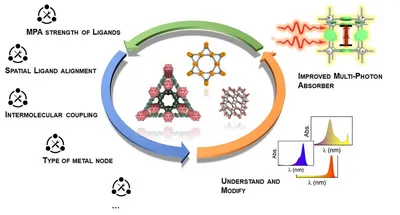
Optimising two-photon absorption in coordination polymers
In two-photon absorption, two non-resonant photons are absorbed simultaneously to populate a high-lying excited state. Two-photon absorption is a fundamental effect with applications in high-resolution imaging and lithography with high spatial resolution. Collaborating within the COORNETs network, we design, synthesise and characterise metal–organic frameworks (MOFs) and coordination polymers (CPs). The aim is to increase the probability of two-photon absorption systematically. Our aims are the following:
- Design, build and apply an experiment to measure two-photon absorption spectra in a broad spectral range.
- Apply this method to linker molecules and MOFs/CPs containing these linkers. We explain and model increased two-photon absorption based on structure-property relations of the MOF/CP.
- Our findings will lead to design suggestions for new and improved two-photon absorbing MOFs/CPs.
Involved group members

Yang Cui
yang.cui@tum.de

Hongxing Hao
hongxing.hao@tum.de
Further reading
Quah, H. S.; Chen, W. Q.; Schreyer, M. K.; Yang, H.; Wong, M. W.; Ji, W.; Vittal, J. J. Multiphoton harvesting metal-organic frameworks. Nature Communications 2015, 6. DOI: 10.1038/ncomms8954.
Chen, Z.; Xu, D.; Zhu, M.; Wang, Y.; Feng, J.; Shu, C.; Xiao, S.; Meng, J.; He, J. Gigantic blue shift of two-photon–induced photoluminescence of interpenetrated metal–organic framework (MOF). Nanophotonics 2023, 12 (19), 3781-3791. DOI: doi:10.1515/nanoph-2023-0383
Own work
Weishäupl, S. J.; Cui, Y.; Deger, S. N.; Syed, H.; Ovsianikov, A.; Hauer, J.; Pöthig, A.; Fischer, R. A. Coordination Polymers Based on Carbazole-Derived Chromophore Linkers for Optimized Multiphoton Absorption: A Structural and Photophysical Study. Chem. Mater. 2022, 34 (16), 7402-7411. DOI: 10.1021/acs.chemmater.2c01525.
Weishäupl, S. J.; Mayer, D. C.; Cui, Y.; Kumar, P.; Oberhofer, H.; Fischer, R. A.; Hauer, J.; Pöthig, A. Recent advances of multiphoton absorption in metal–organic frameworks. Journal of Materials Chemistry C 2022, 10 (18), 6912-6934, DOI: 10.1039/D2TC00191H.
